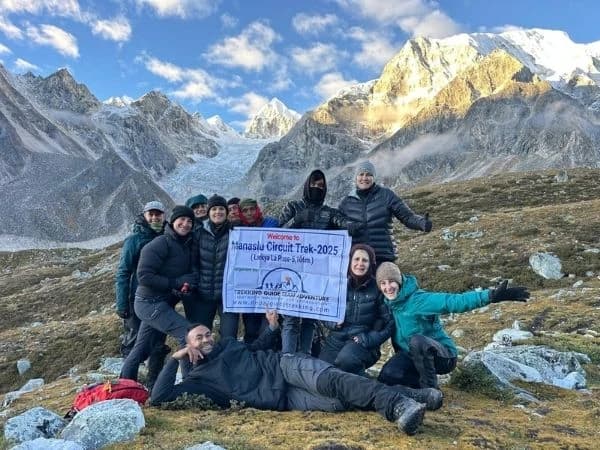Trip Facts:
| Starting Point: Lukla |
Ending Point: Lukla |
| Trek Region: Everest |
Transport: Road/Air |
| Duration: 17 Days |
Trek Difficulty: Difficult |
|
Accommodation: Lodge/Teahouse
|
Max Altitude: 6,189m |
Good To Know About Island Peak Climbing:
Island Peak Climbing Highlights and Attractions
Island Peak Climbing is a kaleidoscope of remarkable attractions that leave trekkers in awe at every turn, as it is part of Everest Region Trek.
As we navigate through enchanting landscapes, we'll be treated to postcard-perfect views of mighty Himalayan peaks, including Lhotse, Nuptse, and Ama Dablam.
The journey takes us through charming Sherpa villages, where colorful prayer flags flutter in the mountain breeze, and sacred monasteries resonate with spiritual energy.
The crowning jewel is the climb to Island Peak's summit, standing proudly at 6,189 meters and offering panoramic vistas of the surrounding peaks and valleys that will take your breath away.
Island Peak Climbing Difficulty Level and Physical Fitness Requirements
Although climbing Island Peak is a once-in-a-lifetime experience, it requires a good deal of stamina and strength. The path winds its way up steep inclines and through a variety of landscapes, from verdant forests to rocky moraines. For the Island Peak Climb, prior trekking experience is helpful but not required, as our knowledgeable guides will offer assistance and guarantee a risk-free trip.
Basic mountaineering skills are helpful for the summit ascent, and our team will offer guidance and training to prepare you for the climb.
The Best Time to Undertake the Island Peak Trek
Having a truly remarkable time on the Island Peak Trek requires careful planning. The best times to climb Island Peaks are in the spring (March through May) and fall (September through November). During these times, the weather is reliable, the skies are clear, and the surrounding mountains look magnificent.
The vibrant colors of autumn and the blooming rhododendrons of spring make every step a visual treat. Get ready to experience the wonders of nature, learn about the fascinating Sherpa culture, and take on the adventure head on as we set out on our trek to the summit of Island Peak.
Let the Himalayas unveil their secrets as you ascend to new heights and create memories that will stay etched in your heart forever.
Preparing For The Expedition:
As you get geared up for the Island Peak trek, thorough preparation is the key to ensuring a successful and enjoyable journey. From essential gear to physical conditioning, here's a comprehensive guide to help you gear up for this epic Himalayan adventure.
1. Physical Fitness and Training:
A high level of physical fitness is required for the Island Peak trek, as we will be hiking for many hours per day and making significant elevation gains. Your stamina will increase if you have done cardio exercises like running, hiking, or cycling before. You can further improve your ability to ascend steep terrain by engaging in core- and leg-focused strength training exercises. The best way to prepare for such an arduous journey is to begin an exercise routine several months in advance.
2. Essential Island Peak Climbing Gear and Equipment:
To ensure a safe and enjoyable journey, be sure to bring along all the essential gear. If you are going trekking, make sure you have a good pair of sturdy boots that fit well and offer plenty of ankle support. You can stay warm and dry in any climate by dressing in layers. These layers should include a moisture-wicking base layer, an insulating mid-layer, and a waterproof outer shell. Bring along a sturdy headlamp, trekking poles, and a warm sleeping bag designed for sub-zero temperatures.
3. Acquiring Necessary Island Peak Climbing Permits:
You need official permission from the Nepali government to trek to Island Peak. The Sagarmatha National Park Entry Permit and the Island Peak Climbing Permit are two of the most important permits. These permits help conservation efforts and look out for your well-being as you set out on an unforgettable adventure. Do not worry; we will handle securing the necessary licenses and permissions on your behalf.
4. Choosing a Reputable Trekking Agency or Guide:
The importance of hiring a trustworthy trekking agency or knowledgeable guide cannot be overstated, as the journey to Island Peak is truly once in a lifetime. A reliable company will supply you with detailed itineraries, expert Island Peak Climbing Guides, and a safety and comfort team.
5. Mental Island Peak Climbing Preparation and Mindset:
Trekking to Island Peak is not merely a physical endeavor; it also requires mental resilience. Embrace the challenges and uncertainties with a positive mindset, as they are an integral part of the journey. Moments of fatigue and doubt may arise, but remember that our experienced guides are there to motivate and support you. Embrace the beauty of the Himalayas and stay connected with nature to find a sense of peace and fulfillment during the trek.
6. Familiarizing with Islanding Peak Climbing Training and Techniques:
The summit climb to Island Peak involves basic mountaineering skills, such as using ice axes, crampons, and ropes. Before the ascent, our experienced guides will provide training on these techniques to ensure your safety during the climb. So, don't worry if you're new to mountaineering – our team will equip you with the necessary skills to conquer the peak.
Day-by-Day Island Peak Trek Itinerary:
Get ready to immerse yourself in the splendors of the Island Peak trek as we take you through the day-by-day itinerary of this Himalayan odyssey. Each step of the journey is carefully crafted to ensure an enriching experience and gradual acclimatization to the high altitudes.
Day 1: Welcome to Kathmandu!
- Altitude: 1,400 m / 4,593 ft
- Accommodation: Hotel
Our team will cordially welcome you at the airport and convey you to your hotel. Take this day to relax, explore the city's rich cultural heritage, and prepare for the exhilarating adventure that lies ahead.
Day 2: Kathmandu to Lukla Flight and Trek to Phakding
- Altitude: Lukla - 2,860 m / 9,383 ft;
- Phakding: 2,651 m / 8,697 ft
- Flight Duration: 35 minutes
- Trekking Hours: 3 hours
- Accommodation: Tea House
Early in the morning, we catch a thrilling flight to Lukla, a small mountain airstrip in the heart of the Everest region. The short but scenic flight treats us to breathtaking views of the Himalayan peaks. After landing in Lukla, we start our trek towards Phakding, passing through charming villages and crossing suspension bridges adorned with prayer flags. Our first day's trek sets the perfect tone for the journey ahead.
Day 3: Phakding to Namche
- Altitude: Namche - 3,440 m / 11,286 ft
- Trekking Hours: 5 to 6 hours
- Accommodation: Tea House
Leaving Phakding behind, we travel along the Dudh Koshi River, which winds through rhododendron forests and other verdant landscapes. Sagarmatha National Park is a UNESCO World Heritage site, and the trail will take us right to its doorstep. After a strenuous climb, we reach Namche Bazaar, where we are rewarded with breathtaking panoramas of Everest and the surrounding peaks. Namche Bazaar, a bustling Sherpa settlement, serves as our entry point to the Everest region and as a crucial acclimatization stop along the way.
Day 4: Acclimatization Day in Namche
- Altitude: 3,700m / 12,139 ft.
- Trekking Hours: 4 to 5 hour
- Accommodation: Tea House
Today is set aside for acclimatization to the higher altitude. As part of our efforts to acclimate, we will walk the short distance to the Everest View Hotel, which boasts breathtaking views of Everest, Ama Dablam, and the other mountains in the area. You could also spend some time in Namche Bazaar learning about the area's rich history by touring the town's monasteries and chatting with the helpful locals.
Day 5: Namche to Tengboche
- Altitude: Tengboche - 3,956m / 12,979 ft.
- Trekking Hours: 5 to 6 hours
- Accommodation: Tea House
We leave Namche and make our way through forests of juniper and rhododendron while taking in stunning panoramas of the Himalayas. Tengboche Monastery, considered by many to be the spiritual center of the Everest region, is our destination on this trek. Everest and Ama Dablam provide a stunning backdrop to the tranquility of the monastery.
Day 6: Tengboche to Dingboche
- Altitude: Dingboche - 4,380 m / 14,370 ft
- Trekking Hours: 4 to 5 hours
- Accommodation: Tea House
The terrain we will be traversing today is primarily alpine, and we may see musk deer and Himalayan pheasants along the way. The landscape changes to a more arid one as we continue to climb. Dingboche, in the Imja Valley, greets us with its picture-perfect vistas of Lhotse and Island Peak.
Day 7: Acclimatization Day in Dingboche
- Altitude: 4,380m / 14,370 ft.
- Trekking Hours: 3 to 4 hours
- Accommodation: Tea House
We will stay in Dingboche for another day to acclimate. To take in the breathtaking vistas of the surrounding mountains, take a leisurely stroll up Nagarjun Hill, or just sit back and enjoy the peace and quiet of this mountain community.
Day 8: Dingboche to Lobuche
- Altitude: Lobuche - 4,938m / 16,200 ft.
- Trekking Hours: 4 to 5 hours
- Accommodation: Tea House
After leaving Dughla, we will continue on foot to Lobuche, from where we will have spectacular views of Nuptse, Pumori, and other towering peaks. Our final push for Island Peak begins after a restful night in Lobuche.
Day 9: Lobuche to Gorakshep
- Altitude: Gorakshep – 5,160m / 16,929 ft.
- Trekking Hours: 2 to 3 hours (Lobuche to Gorakshep); 4 hours (Gorakshep to Everest Base Camp)
- Accommodation: Tea House
Today's trek takes us to Gorakshep, the last settlement before reaching Everest Base Camp. After a brief rest, we embark on an exhilarating journey to Everest Base Camp. The trail winds through the Khumbu Glacier and offers surreal views of ice seracs and crevasses. With the highest peaks in the world all around you, standing at the famous Everest Base Camp is an unforgettable experience.
Day 10: Gorakshep to Lobuche
- Altitude: Lobuche, 4,938m / 16,200 ft.
- Trekking Hours: 4 hours (Gorakshep to Kala Patthar); 4 hours (Kala Patthar to Lobuche)
- Accommodation: Tea House.
To see the sunrise over Everest, we got up early and hiked to Kala Patthar, one of the best viewpoints. Everest, Lhotse, and Nuptse, as well as the Khumbu Glacier, can be seen in their entirety, making for truly breathtaking scenery. We will have breakfast in Gorak Shep and then head back to Lobuche for a much-needed break.
Day 11: Lobuche to Chukung via Kongma La Pass
- Altitude: Chukung, 4,730m / 15,518 ft.
- Trekking Hours: 6 to 7 hours
- Accommodation: Tea House
As we leave Lobuche, we will be crossing the treacherous Kongma La Pass, which provides breathtaking views of Island Peak and the surrounding Himalayas. Before attempting Island Peak, we can put our mountaineering skills to the test on the pass. After a long day of hiking, we made it to Chukung, a quaint mountain village.
Day 12: Chukung to Island Peak Base Camp
- Altitude: Island Peak Base Camp – 5,087m / 16,690 ft.
- Trekking Hours: 7 hours
- Accommodation: Camping
Today's journey takes us to Island Peak Base Camp, where we set up our campsite in preparation for the summit ascent. Beautiful vistas of the surrounding peaks can be seen from the trail as we make our way through rocky terrain and glacial moraines. We will get our final instructions and gear up for the exciting climb at Base Camp.
Day 13: Island Peak Base Camp to Summit and Down to Chukung
- Altitude: Island Peak Summit, (6,189m / 20,305 ft.); Chukung, (4,730m / 15,518 ft.)\
- Trekking Hours: 12 to 14 hours (Summit and return to Chukung)
- Accommodation: Tea House
The most challenging day of our expedition has arrived. We wake up early to begin our summit ascent. The climb involves using crampons, ice axes, and ropes as we negotiate steep ice and snow slopes. Finally, standing atop the summit of Island Peak, we are rewarded with breathtaking panoramic views of the Everest region. After savoring the moment, we carefully descend back to Chukung for a well-deserved rest.
Day 14: Chukung to Pangboche
- Altitude: Pangboche – 3,985m / 13,074 ft.
- Trekking Hours: 5 to 6 hours
- Accommodation: Tea House
As we bid farewell to Chukung, we retrace our steps back to Pangboche. The trail takes us through picturesque landscapes and charming Sherpa villages. Pangboche welcomes us with its serene ambiance and warm hospitality.
Day 15: Pangboche to Namche
- Altitude: Namche – 3,440m / 11,286 ft.
- Trekking Hours: 6 to 7 hours
- Accommodation: Tea House
Descending further, we head back to Namche Bazaar. The familiar trails allow us to relish the scenic beauty once more. In Namche, you can celebrate your successful expedition with fellow trekkers and share memorable experiences.
Day 16: Namche to Lukla
- Altitude: Lukla – 2,860m / 9,383 ft.
- Trekking Hours: 6 to 7 hours
- Accommodation: Tea House
The final leg of our trek takes us back to Lukla, where it all began. Relish the memories and achievements of the past days as you bid farewell to the Everest region's stunning landscapes.
Day 17: Lukla to Kathmandu Flight
- Altitude: Kathmandu – 1,400m / 4,593 ft
- Flight Duration: 35 minutes
- Accommodation: Hotel
Board the scenic flight from Lukla to Kathmandu, where you can rest and reflect on your extraordinary adventure. Spend the evening enjoying the vibrant streets and savoring the taste of Nepali cuisine.
Day 18: Departure
As you leave the magical country of Nepal, remember all the good times you had there. The memories of conquering Island Peak and the breathtaking Himalayan landscapes will forever stay etched in your heart. Until we meet again for another adventure in the Himalayas!
If you have prior trekking experience in Nepal and want to make this adventure shorter, get in touch with us now to personalize your climbing plan!
Island Peak Climbing Packing List:
Packing for an Island Peak climbing expedition requires careful planning to ensure you have all the necessary gear and equipment to tackle the challenges of the Himalayas. Here's a comprehensive packing list to help you prepare for the adventure of a lifetime:
Clothing:
• Base Layer (Moisture-wicking shirts and pants)
• Insulating Layer (Fleece or down jacket)
• Waterproof and Windproof Jacket
• Waterproof and Windproof Pants
• Trekking Pants (Convertible ones are ideal)
• Thermal Underwear
• Long-sleeve Shirts
• Short-sleeve Shirts
• Trekking Socks (Several pairs)
• Warm Hat (Beanie)
• Sun Hat
• Gloves (Inner and outer layers)
• Gaiters (to keep snow out of boots)
Footwear:
• Sturdy Trekking Boots (broken-in and waterproof)
• Camp Shoes (e.g., lightweight sandals or sneakers)
Climbing Gear:
• Climbing Helmet
• Crampons
• Ice Axe
• Harness
• Ascender (Jumar) and Descender (Figure 8)
• Carabiners and Locking Carabiners
• Climbing Harness
• Climbing Sling
• Prusik Cord
• Mountaineering Boots (Double boots for high altitudes)
Backpacks and Bags:
• Expedition Backpack (50-70 liters) with rain-cover
• Daypack (25-35 liters) for summit day
• Duffel Bag (Waterproof and durable for porters)
• Compression Bags (for organizing gear)
Sleeping Gear:
• Sleeping Bag (4-season and suitable for sub-zero temperatures)
• Sleeping Bag Liner (Optional, for extra warmth and hygiene)
Personal Items:
• Personal Identification (Passport, permits, and travel insurance)
• Cash (Nepalese Rupees and USD for emergencies)
• Water Bottles or Hydration System (at least 2 liters capacity)
• Water Purification Tablets or Filters
• Snacks (Energy bars, nuts, and chocolates)
• Sunglasses (UV protection with side shields)
• Sunscreen (High SPF)
• Lip Balm with Sunscreen
• Personal Toiletries (Toothbrush, toothpaste, wet wipes, etc.)
• Trekking Poles (optional but helpful for stability)
Technical Equipment:
• Headlamp with Extra Batteries
• Camera with Extra Batteries and Memory Cards
• Portable Solar Charger or Power Bank
• Personal First Aid Kit (Band-Aids, antiseptic cream, painkillers, etc.)
• Blister Kit (Moleskin for blister pads)
Miscellaneous:
• Trekking Towel
• Multi-tool Knife
• Whistle (for emergency signaling)
• Personal Snacks and Comfort Items
• Book or Kindle (for leisure time)
Optional Gear:
• Binoculars (for wildlife and mountain views)
• Portable Altitude Chamber (PAC) Bag (for emergency use)
Remember to pack light but efficiently, as you'll be carrying your gear during the trek. Remember to check the weather forecast and consult your trekking guide for gear or specialized items required for Island Peak climbing. Proper preparation will ensure a safe and successful ascent to the Himalayan summit.
Frequently Asked Questions about Island Peak Climbing:
1. What is Island Peak?
✔ Island Peak, also known as Imja Tse, is a popular climbing peak situated in the Everest region of Nepal. It stands at an impressive altitude of 6,189 meters (20,305 feet) and offers breathtaking panoramic views of the surrounding Himalayan peaks.
2. Is Island Peak Climbing suitable for beginners?
✔ While Island Peak is considered a beginner-friendly peak for climbers with some previous mountaineering experience, it still requires a good level of physical fitness, stamina, and basic climbing skills. Adequate acclimatization and proper training are essential for a successful climb.
3. What are the highlights of Island Peak Climbing?
✔ The Island Peak Climbing Expedition not only offers the thrill of summiting a Himalayan peak but also takes you through picturesque Sherpa villages, rhododendron forests, and stunning glacial landscapes. The journey provides an authentic taste of Himalayan culture and breathtaking views of Everest, Lhotse, Nuptse, and Makalu.
4. When is the best time for Island Peak Climbing?
✔ The best time for Island Peak Climbing is from March to May and from September to November. The pre-monsoon and post-monsoon seasons are all about stable weather, clear skies, and favorable climbing conditions.
5. What level of physical fitness is required for Island Peak Climbing?
✔ Climbers attempting Island Peak should be in excellent physical condition and have prior trekking experience at high altitudes. Regular cardiovascular training, strength exercises, and endurance workouts are essential to prepare for the demands of the climb.
6. Do I need any climbing experience to attempt Island Peak?
✔ Climbers should be familiar with the use of mountaineering equipment like crampons, ice axes, and ropes, but experience is not required. You should strongly consider enrolling in a pre-climb training course under the direction of a qualified guide.
7. How long does the Island Peak Climbing Expedition take?
✔ The standard Island Peak Climbing itinerary takes around 18 to 20 days, including the trek to and from Lukla, acclimatization days, and the ascent to the summit. The actual climbing period varies based on weather conditions and the pace of the group.
8. Is technical gear provided during the climb?
✔ Climbers are responsible for bringing their technical climbing gear, including crampons, ice axes, harnesses, and helmets. Most climbers rent or purchase these items in Kathmandu before the expedition.
9 .Is Island Peak Climbing dangerous?
✔ Like all high-altitude mountaineering activities, Island Peak Climbing involves inherent risks. However, with proper training, experienced guides, and adherence to safety protocols, the risk can be minimized. Climbers should be prepared for extreme weather conditions and be cautious of altitude-related challenges.
10. Is Island Peak Climbing permitted throughout the year?
✔ Island Peak Climbing is permitted throughout the year, but the best climbing seasons are spring and autumn. The winter and monsoon seasons bring adverse weather conditions, making climbing more challenging and risky.
Other Peak Climbing Routes:
✅ Lobuje Peak Climbing
✅ Mera Peak Climbing
✅ Pisang Peak Climbing
✅ Chulu West Peak Climbing





